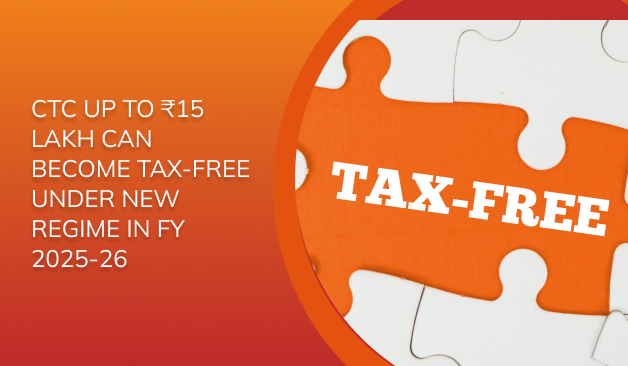
CTC Up to Rs 15 Lakh Can Become Tax-Free Under New Regime in FY26
The Union Budget 2025 introduced a great benefit for salaried employees. Are you a salaried employee, and want to know the details? Read this article to know more
The budget introduced nil tax on taxable income up to Rs 12 lakh under the new tax regime. For salaried employees, the tax-free limit goes up to Rs 12.75 lakh, thanks to the Rs 75,000 standard deduction.
Now, many salaried employees are wondering if their CTC (Cost to Company) needs to be Rs 12 lakh to enjoy this tax benefit, or if a higher CTC could still qualify for zero tax. The answer is that your CTC can be more than Rs 12 lakh, and you can still benefit from nil tax, as long as your taxable income (after exemptions and deductions) is Rs 12 lakh or less.
Taxable Income vs. Salary Package/CTC
Many people confuse CTC (Cost to Company) with taxable income, but they are quite different. Let us understand the difference.
Salary Package or CTC
CTC (Cost to Company) is the total expense a company incurs for an employee. It includes:
- Basic salary
- Allowances (HRA, travel, medical, etc.)
- Employer contributions to EPF, NPS, gratuity, etc.
- Perquisites & other benefits (bonus, insurance, etc.)
CTC is the gross cost before any deductions and does not represent your actual take-home salary.
Taxable Income
Taxable income is the portion of your earnings on which tax is calculated. It is derived after subtracting eligible exemptions and deductions from your gross salary.
Taxable Income = Gross Salary – Exemptions – Deductions
Can You Get Zero Tax on CTC Above Rs 12 Lakh?
Yes, it is possible, but it requires smart structuring of your salary package. Tax experts say that by adjusting components like dearness allowance, house rent allowance, LTA, conveyance reimbursements, and employer contributions to EPF and NPS, you can reduce your taxable income to Rs 12 lakh or less, even if your CTC exceeds Rs 12 lakh.
For example, let us look at how someone with a Rs 15 lakh CTC can still have a taxable income of Rs 12 lakh:
|
Particulars |
Yearly (Rs) |
|
Basic Salary |
5,56,000 |
|
Dearness Allowance |
1,76,500 |
|
House Rent Allowances (HRA) |
2,53,000 |
|
Leave Travel Assistance (LTA) |
73,250 |
|
Conveyance Reimbursement |
38,000 |
|
Training Reimbursement |
35,000 |
|
Special Allowance |
1,83,450 |
|
Employer's Contribution to PF |
87,900 |
|
Employer's Contribution to NPS |
1,02,550 |
|
Gross Salary |
15,05,650 |
Exemptions/Deductions:
- Employer's Contribution to PF: Rs 87,900
- Conveyance Reimbursement: Rs 18,000
- Training Reimbursement: Rs 15,000
- Standard Deduction: Rs 75,000
Total Deductions: Rs 2,03,100
After applying deductions, the gross total income comes to Rs 13,02,550. By using deductions under Section 80CCD(2) for NPS contributions, the net taxable income reduces to Rs 12,00,000, which results in zero tax due to the rebate under Section 87A.
Can You Get Nil Tax on a Salary Above Rs 15 Lakh?
Yes, technically, it is possible to lower down tax structure on your salary even if your it exceeds Rs 15 lakh, as long as you have the right salary components (like DA, HRA, NPS contributions, etc.) to maximize deductions and rebates.
Things to Consider/Chanllenges
While it is possible to claim nil tax on higher salaries, it may not be easy, as it depends on your employer’s willingness to adjust your salary package and your personal financial needs. Also, some benefits like dearness allowance might not be included in private sector salary packages.
Plus, if you want to claim certain exemptions (like conveyance or training reimbursements), you will need to submit actual bills, which could be tricky if you don’t spend that much.
Before you go
In short, restructuring your salary to qualify for the nil tax benefit requires careful planning and cooperation from your employer, but it can be done, even if your CTC is over Rs 12 lakh.










